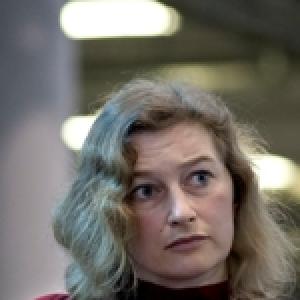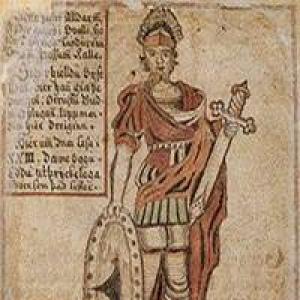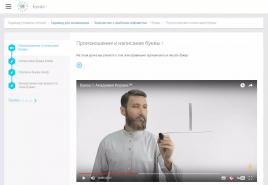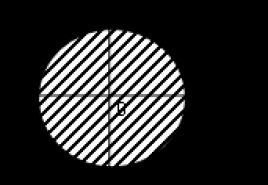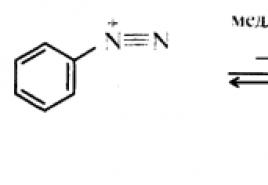Wolf at the kennel analysis. Comprehensive analysis of I.A.’s fable
The true glorification of Kutuzov, his national genius as a military man and diplomat, was given by Krylov in the fable “The Wolf in the Kennel.” This work of the poet is a miracle of the art of words. Here allegory triumphs both as an allegory, that is, poetics of a wide range of action, and as (for all its conventionality) the maximum approximation to reality, in the sense of this particular case. Here the art of portraiture also won its victory, capturing the whole person from head to toe with one line, one stroke.
What would later delight Gogol in Krylov and become for him high school poetry.
But it should also be said that when reading Krylov’s brilliant creation, you see in the poet not only an artist who described the great commander, but also a person involved in the genius of Kutuzov.
The fable was written under the following widely known circumstances. Having fallen into the “net” set by Smolensky, Napoleon on September 23 (before the fire) made a proposal for peace negotiations. Kutuzov rejected them. Which corresponded to both the commander’s plan for the entire campaign and the mood of the army, which was literally eager to go into battle and was only waiting for a signal.
The genius of Krylov’s story lies precisely in the fact that the poet, in 34 verses, not only conveyed the features of this situation, which became a collision, but also revealed it as a socio-historical situation, which not only did not interfere with, but also contributed to, the allegory, making it possible to economically “spend” artistic means at their maximum expressiveness. That is why, on such a small platform, the situation appeared before us (following Hegel in terminology) as a general state of the world. And moving from the language of philosophical abstractions to the language of concrete historical definitions, like the mood of the masses, like the state and level of the popular movement. In 1812, Belinsky wrote, the nation began to move, and a poetic reality was formed. Patriarchy was severely shaken. Which is what fertilized Pushkin’s genius.
But in fairness, it should be said that the first poet to directly observe this new reality and recreate it in a picture of amazing power was Krylov. The fable “The Wolf in the Kennel” is remarkable precisely because it reproduces the truth of history, the atmosphere of popular upsurge, activity and audacity of the masses making history. Without this, the image of the Hunter, which concludes Krylov’s story, would be lonely, incomplete, unclear and impossible in its wisdom.
As always, Krylov needed one or two verses to introduce him to a poetic situation. The wolf at night, thinking of getting into the sheepfold, ended up in the kennel. Everything has been said. And then - natural result, which is everything but a misunderstanding.
This is history.
The hounds shout: “Wow, guys, thief!”
And instantly the gates are locked...
It seemed like it was already a climax. The tension is so strong and furious that there is nowhere to go further. “The gate is locked” also puts a certain point. But it turned out not to be so. This is not a fable yet, but only a fable. The fable will be ahead - the poet used to say. Yes, the most important thing, like the rapid growth of the decisive, like the picture of the general “frenzy of the people” - all this is ahead. And it thundered:
They run: another with a club,
Another with a gun.
“Fire! - they shout. “Fire!”
Here only the increase in tension ended.
In the literature it was noted: “with a club”, “with a gun” - a picture of popular enthusiasm - a picture of guerrilla warfare. Apparently, “Fire” should also be included here, the pinnacle in the picture and reuniting the two levels of the fable: allegorical (wolves are most afraid of fire) and real-historical (fire is one of the most powerful weapons of guerrilla, people's war).
In this case, “fire” is both lighting and weapons; it wouldn’t hurt, they say, to burn the prankster a little, also “for order.”
After the “fire” decided the matter, Krylov takes a “peaceful break.” They came with fire. And we are witnessing a wonderful metamorphosis that Publius Ovid Naso would envy. The Wolf became the Fox. It seems that Krylov has the only case. But what is characteristic of this crossbreed, which must be attributed to the great art of the writer: the Fox remains the Wolf, and the Wolf does not cease to be the Fox. Here we are faced with a purely Pushkinian theory of character: opposites are interpenetrated. Let's see how this happens.
After the calm “They came with fire” (not “They ran with fire”!), which indicates the decision and completion of the matter - the tension has subsided, the situation is clear, the light is “on”, the advantage is determined and certain, Krylov continues:
My Wolf sits with his backside pressed into the corner,
(the best defensive position, by the way: the rear is protected)
Teeth snapping and fur bristling...
(he hopes for something, he hasn’t seen everything yet; the image is picturesque and sonorous)
With his eyes, it seems like he would like to eat everyone...
(his desires and intentions, his nature remained unchanged; the Wolf remains the Wolf, fable characters are steadfast: they always look from the forest into the sheepfold)
But, seeing what is not in front of the herd...
(that is, he hoped until recently, until the last second hope did not leave him - this is how Krylov understood the Wolf and his “prototype” Napoleon)
My cunning man set off
In negotiations,
What a long phrase. It couldn't be shorter: The Wolf needs time to change his clothes, like any actor. And this process of changing clothes is an additional burden (super task?) of the entire phrase.
Let us just note the amazing endings of three verses in a row, these closed syllables, masculine rhymes, sonorous final “ts”, supplementing, as it were, the meaning of the word “finally”, cutting off and cutting off any possibility of a different outcome for the Wolf, and the verse that replaces them, the shortest, but within these limits the longest -
Negotiation -
the verse clearly slowed down - five open syllables, which exceeds the previous three verses in duration. It’s understandable: the Wolf needs to buy time. He needs a guy. In addition, “negotiations” also take a long time. It's time too.
The Wolf's speech, of course, is the height of diplomatic art. Limit of camouflage. But Krylov, giving him complete will and freedom to disguise himself, without interfering or constraining him in anything (the problem of the image in its objectivity is completely preserved here), sees at the same time the Wolf in the Wolf, although he did everything to become the Fox, the friend and brother of the hounds guarding the sheep.
The wolf spoke out completely. “Lad” - “stad” - “glad”, You can truly believe this.
But “glad to squabble” and “wolf oath” (and he could not say anything else) cry out against the union - these combinations expose. The oath explodes, nature makes itself felt, which is what the hunter saw.
The Wolf’s most skillful speech in diplomacy at the “peace” negotiations was interrupted by the hunter, who until time held back the hounds: negotiations were underway.
“Listen, neighbor,”
Here the hunter interrupted in response, -
You are gray, and I, my friend, am gray..."
Contemporaries say that, reading these lines, Kutuzov took off his cap, bowed his head and showed his gray hair. A fact worthy of a historical canvas. This would be a picture about the great commander and great artist - Krylov, who captured in one stroke the image of Kutuzov, completely and completely.
This is not only a portrait of a person, but also his psychological appearance. Not only old age, but also wisdom. And not only a wonderful portrait of the commander, but also a self-portrait of the poet himself. Having said everything about Kutuzov, he said everything about himself. And in just one word. Short as a shot and as strong as a blow from a brush.
Summary of a literature lesson in 5th grade on the topic:
“I.A. Krylov’s fable “Wolf in the kennel.” Allegory and morality."
Novik N.G., teacher of Russian language and literature, State Budgetary Educational Institution JSC “Vychegda SKOSHI”.
Goals: introduce to brief information from the life of I.A. Krylov, with the fable “Wolf in the Kennel”; continue to develop the ability to understand the allegorical subtext of the fable and its moral.
Tasks:
educational:
develop the ability to find the necessary information;
identify the main idea of the fable;
emphasize the importance of morality as a compositional element, which is the focus of the ideological content of the fable;
developing the ability to analyze a plot, a system of images and construct a fable;
introduce the term “allegory”;
developing skills in working with illustrations;
improve expressive reading and role-playing skills;
improve the skill of conscious reading;
developing:
develop students' speech; introduce terms: morality, personification, allegory, repeat, bully, matchmaker, godfather;
intensify cognitive activity in literature lessons, develop interest in reading ;
develop communication and information competencies;
disclose creativity students.
develop attention, ability to perceive and evaluate phenomena fiction and form spiritual and moral qualities, aesthetic taste;
educational:
to cultivate interest, respect for the subject, and a value-based attitude to the word;
formation and education of a spiritually developed personality;
cultivate a negative attitude towards a person’s vices and shortcomings as flattery, self-interest, ingratiation.
Visibility and equipment: portrait of I.A. Krylov, illustrations for fables, cards with words and phrases, recording of fables, recording of proverbs on the board, textbook: Literature, 5th grade. Textbook-reader for educational institutions. At 2 o'clock. Auto-stat. V.Ya.Korovina and others - 5th ed. – M.: Education, 2011
Epigraph for the lesson:
Storyinsists - that's what a man is like,
and it should be like -broadcasts fable.
PROGRESS OF THE LESSON
1.Org.moment
1.Psychological attitude.
Hello guys! I'm glad to see you all healthy, cheerful, smiling. I really hope that you and I will work well and actively today, and that you will gain knowledge and decent grades.
2.Communication of the topic and objectives of the lesson.
Today in the lesson we will continue our acquaintance with the work of I.A. Krylov, we will try to reveal the secrets, charm and power of the fable “The Wolf in the Kennel”. But first, let's look at the epigraph of the lesson.
What is an epigraph? (Epigraph – “window into the author’s soul”, “window into the soul of the work”, “window into the essence of the lesson”).
Let's read it.
How do you understand the words “says” and “broadcasts”?
& Vocabulary work. Working with explanatory dictionaries.
Reaffirm - keep saying the same thing
Broadcast – predict, speak
How does the epigraph fit into the lesson? We'll talk about this at the end of the lesson.
3.Repetition of the material covered, checking the house. assignments.
Blitz roll call based on the results of a home survey. Analysis of test tasks.
"Biography of I.A. Krylov."
Mark the datebirth of I.A. Krylov
2. Determine the place of birth of I.A. Krylov
A) Moscow
B) St. Petersburg
3. The boy was raised by:
A) grandmother
4. Eight-year-old Krylov worked:
A) loader
B) washed the dishes
B) a copyist of papers
5. Krylov becomes more known as:
A) fabulist
B) journalist
B) publisher
6. Ivan Andreevich Krylov created:
A) More than two hundred fables
B) More than three hundred fables
B) More than a hundred
2) Repetition of information about the fable and its features (textbook material pp. 55-56)
Answer, what is a fable and what are its features?
Reception "Unfinished sentences".
- Continue the sentences:
Fable is short story …
Moral - opening or closing lines...
The fable consists of...
In fables we often meet...
Personification is...
Allegory is...
What new did you learn about the fable?
Result: Fables have an interesting short entertaining plot, with few descriptions and a lot of dialogue. There are usually several heroes, so they are easy to remember, especially the main one, which expresses the main idea. Fables are somewhat reminiscent of fairy tales: wild animals, birds, fish, objects in them talk and act as in fairy tales. Many fables are funny; with the help of laughter it is easy to convey the idea of harm bad habits and properties of human character.
4. Acquaintance with I.A. Krylov’s fable “The Wolf in the Kennel.”
1).Teacher's word:
The plot of the fable “The Wolf in the Kennel” is based on the events of the War of 1812. When Napoleon entered Moscow and realized that the Russian army was not defeated, but was gaining strength. The great Russian fabulist captured these events in his fable.
2). Expressive reading fables by the teacher.
What is this fable about?
Who main character fables?
3). Reading fables by students.
Read the fable and highlight the unfamiliar words.
4). General conversation.
Where did the wolf want to climb?
& Vocabulary work
A sheepfold is a barn for sheep.
Where did you end up? Why?
How did you react to the appearance of a wolf in the kennel?
Complete the sentence:
The entire kennel yard rose: dogs ... and ...; hounds...; running:...,...
& Vocabulary work
A bully is someone who likes to start fights and quarrels.
How does the Wolf behave? Describe it using the illustration on page 59
Why does the Wolf begin to be cunning?
Find in the fable and read the reason for his cunning?
& Vocabulary work
Matchmaker – relative (parent of one of the spouses)
Godfather - godfather in relation to the godson's parents
How do you understand the expression: “You are gray, and I, my friend, am gray...”?(talks about the age of the Hunter, about his experience in fighting invaders).
5). Reading in the faces of the dialogue between the Wolf and the Hunter.
6). Characteristics of the Wolf and the Hunter.
An exercise in selecting qualities that characterize the heroes of the fable.
Insidious - Wolf
Experienced - Hunter
Wise - Hunter
Treacherous - Wolf
Sly – Wolf
Prudent - Hunter
Cowardly - Wolf
7).Working with words of morality.
What is the theme of the fable?
Where is the theme reflected?
Fable idea?
Where is its meaning? (There is no other way to make peace with wolves than by skinning them).
What is morality?
How do you understand the words of morality? (The wolf is a predator, and even if he offers peace negotiations, he still remains a predator that must be destroyed).
5. Homework:
1. Expressive reading of the fable “The Wolf in the Kennel” p. 59 – 60.
2.Make an illustration for the fable.
6. Summing up the lesson.
What did we start learning in class?
What is the moral of the fable?
How does the epigraph fit into the lesson?
Did you find the lesson useful? How?
7.Reflection:
1. The lesson is useful, everything is clear.
2. Only one thing is a little unclear.
3. You still have to work hard.
4. Yes, it’s still difficult to study.
The wolf wanted to eat the sheep, but instead of the sheepfold he accidentally climbed into the kennel. The dogs, sensing the wolf spirit, made a noise and barked. The hounds brought fire to see what was causing such a commotion. The wolf, realizing that in front of him were not sheep, but dogs, and that now the end would come to him, decided to cheat. He said that he had come to make peace, that he would never steal sheep again, and would even protect them from other wolves. But the huntsman did not believe the Wolf and unleashed the dogs on him.
Read the fable Wolf in the kennel online
The wolf at night, thinking of getting into the sheepfold,
I ended up at the kennel.
Suddenly the whole kennel yard rose up -
Smelling gray so close to the bully,
The dogs are flooded in the barns and are eager to fight;
The hounds shout: “Wow, guys, thief!”
And instantly the gates are locked;
In a minute the kennel became hell.
They run: another with a club,
Another with a gun.
“Fire!” they shout, “fire!” They came with fire.
My Wolf sits with his backside pressed into the corner.
Teeth snapping and fur bristling,
With his eyes, it seems he would like to eat everyone;
But, seeing what is not here in front of the herd
And what finally comes
He has to pay for the sheep, -
My cunning man set off
In negotiations
And he started like this: “Friends! Why all this noise?
I, your old matchmaker and godfather,
I came to make peace with you, not at all for the sake of a quarrel;
Let's forget the past, let's establish a common harmony!
And not only will I not touch the local herds in the future,
But I’m happy to fight for them with others
And I affirm with a wolf’s oath,
What am I..." - "Listen, neighbor, -
Here the hunter interrupted in response, -
You are gray, and I, my friend, am gray,
And I have long known your wolfish nature;
Therefore, my custom is:
There is no other way to make peace with wolves,
Like skinning them off.”
And then he released a pack of hounds at the Wolf.

(Illustration by Irina Petelina)
Moral of the story: Wolf in the kennel
The wolf wanted to save his own skin with the help of hypocrisy. But the smart and experienced Hunter knew the habits of wolves, that they could not be trusted, so that they would not say: “You are gray, and I, my friend, are gray.” The fight against any insidious enemy is difficult, but necessary.
The Wolf in the Kennel is a fable by Krylov, allegorically describing the failed negotiations between Napoleon and Kutuzov. The Wolf in the Kennel is a true masterpiece of the fable genre.
Fable Wolf in the kennel read
The wolf at night, thinking of getting into the sheepfold,
I ended up at the kennel.
Suddenly the whole kennel yard rose up -
Smelling gray so close to the bully,
The dogs are flooded in the barns and are eager to fight;
The hounds shout: “Wow, guys, thief!”
And instantly the gates are locked;
In a minute the kennel became hell.
They run: another with a club,
Another with a gun.
“Fire!” they shout, “fire!” They came with fire.
My Wolf sits with his backside pressed into the corner.
Teeth snapping and fur bristling,
With his eyes, it seems he would like to eat everyone;
But, seeing what is not here in front of the herd
And what finally comes
He has to pay for the sheep, -
My cunning man set off
In negotiations
And he started like this: “Friends! Why all this noise?
I, your old matchmaker and godfather,
I came to make peace with you, not at all for the sake of a quarrel;
Let's forget the past, let's establish a common harmony!
And not only will I not touch the local herds in the future,
But I’m happy to fight for them with others
And I affirm with a wolf’s oath,
What am I..." - "Listen, neighbor, -
Here the hunter interrupted in response, -
You are gray, and I, my friend, am gray,
Therefore, my custom is:
Like skinning them off.”
And then he released a pack of hounds at the Wolf.
Moral of the story: Wolf in the kennel
And I have long known your wolfish nature;
Therefore, my custom is:
There is no other way to make peace with wolves,
Like skinning them off.
Fable Wolf in the kennel - analysis
Krylov's fable The Wolf in the Kennel is a patriotic work about significant historical events 1812. The Hunter is Kutuzov, the Wolf is Napoleon, but even a detailed knowledge and understanding of history with a comparison of the behavior of these individuals does not completely cover the deep moral of the fable The Wolf in the Kennel.
In Krylov's fable, much attention is paid to conveying the picturesqueness of all the pictures and the moods of the participants. The anxiety in the kennel is excited by the use of vivid and figurative expressions: “the dogs are eager to fight”... Moreover, the dangerous cunning of the wolf and resourcefulness are especially clearly described: “I did not come to make peace with you for the sake of a quarrel.” The author very easily conveys the mind of the Hunter, who already understands the hypocrisy of the wolf in an attempt to save his own skin. The hunter does not listen to him, but utters the words that become the beginning of morality: “You are gray, and I, my friend, am gray.”
Ivan Andreevich Krylov wrote the fable “The Wolf in the Kennel,” which is symbolically connected with the events Patriotic War 1812. The plot of the work is original.
The entire action of the fable develops in the kennel. The Wolf got into this closed space, intending to kidnap the sheep. There's just a mistake. A fatal, let's say, mistake. The dogs smelled the gray one and started barking. The hounds, hearing the noise and assessing the situation, cut off all escape routes for the predator, closing the gate tightly.
The wolf decided to use a trick. He began to negotiate with the dogs, insisting that they were his distant relatives. The insidious beast tried in every way to get free, he assured that he would never even look in the direction of the sheep again. And if the dogs want, he will even protect them. But everyone knows the wolf's nature. And the Hunter was under no circumstances going to agree to a settlement agreement with this deceiver and cunning man. But he simply unleashed a pack of dogs on the Wolf.
Why is this fable directly related to the War of 1812? Let's find out now. By the Wolf who ended up in the kennel by mistake, Krylov means Napoleon. At the moment when the fable was written, he was already in Moscow and was looking forward to peace with the Russian emperor. Bonaparte enjoyed the victory, being in the clear confidence that he had already won it.
The Russians were in no hurry to agree to the conditions put forward by the arrogant and self-confident Napoleon. While the French ruler was waiting for an answer, he found himself in a trap. Kutuzov began military operations in the rear, making it difficult for the enemy to retreat.
Like the Wolf in Krylov's fable, Napoleon found himself in an unpleasant and even difficult situation. The flattering words of a predatory beast can be equated to the speeches of a French conqueror.
By dogs, Ivan Andreevich means the entire Russian people, eager to fight to defend their country. But the Wolf was locked in the kennel by the Hunter. If we translate this into the historical situation in Russia, then we can claim that Kutuzov himself is the Hunter, who locked the French emperor in Moscow as if in a trap.
The commander-in-chief of the Russian army read Krylov's fable to the soldiers, showing his gray head in confirmation of the words of the Russian fabulist. The soldiers laughed out loud. The great writer, with his works, raised the spirit of the Russian people and directly those who went to the battlefield.
Ivan Andreevich followed what was happening in the country, noticed everything and aptly depicted it in his unsurpassed fables.


